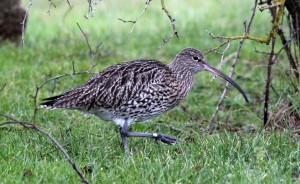 Whilst the various firths along the east coast are famous for their ducks and geese there is an equally important group of birds that often go un-noticed. These are the waders that vary as much in their plumage and size as the ducks. Many are easy to identify such as the curlew with its very long, curved beak, long legs and that sheer size compared with the other wader. The oystercatcher, with its combination of black and white plumage and a long, straight, orange beak, is another easy one. Then, when you get to the smaller waders such as dunlin and knot, the problems over identification arise. One of the issues is that their winter plumage, the time when we see many of them, is very subdued and often drab compared with the breeding one of summer. A good example is the dunlin as its winter plumage is a grey brown back contrasting with the whitish underparts. In summer the breeding plumage is a reddish brown back and a very conspicuous and large black patch on the belly.
Whilst the various firths along the east coast are famous for their ducks and geese there is an equally important group of birds that often go un-noticed. These are the waders that vary as much in their plumage and size as the ducks. Many are easy to identify such as the curlew with its very long, curved beak, long legs and that sheer size compared with the other wader. The oystercatcher, with its combination of black and white plumage and a long, straight, orange beak, is another easy one. Then, when you get to the smaller waders such as dunlin and knot, the problems over identification arise. One of the issues is that their winter plumage, the time when we see many of them, is very subdued and often drab compared with the breeding one of summer. A good example is the dunlin as its winter plumage is a grey brown back contrasting with the whitish underparts. In summer the breeding plumage is a reddish brown back and a very conspicuous and large black patch on the belly.
Although this plumage difference between winter and summer may be conspicuous in some waders, in others there is very little difference. A good example is the largest of the waders, the curlew, as there is very little difference between summer and winter plumage. As with many other waders, the curlews’ annual life cycle, in terms of movements, is fascinating. At this time of the year, curlews are generally only found around the coasts where they use their long beaks to advantage on mud flats to probe for worm’s etc. Then, in the spring, most of them will move inland to their breeding sites such as fields in straths and glens, especially where there is some open moorland. However, this is complicated by the fact that large numbers from Scandinavia start to arrive on Scottish coasts in late summer and will stay for the winter, intermingling with the “resident” curlews. These immigrants boost the local numbers to the extent that there may well be 85,000 present throughout the winter.
Our knowledge of such movements is largely based on birds being ringed and this is one aspect of bird studies that is often overlooked. It is a scheme organised by the British Trust for Ornithology and, in the Highlands, a relatively small group of enthusiasts, under the auspices of the Highland Ringing Group, that ring many thousands of bird each year. The latest “Highland Bird Report 2011” gives details of the number of birds ringed. The Group members ringed a total of 36,458 birds during the year covering a very wide range of species. Some are ringed under special schemes, such as the 1,342 Manx shearwaters and the woodcock at 73 birds. Some of the much smaller birds, such as the siskin, records over 4,000 birds ringed and likewise the great tit at over 1,400 birds. You can often see these rings on birds such as garden birds at feeders and the curlew in the photograph I took on the Cromarty Firth last weekend.
Unfortunately, as regards breeding waders they have been in decline in recent years. A few years ago I reported in this column on the problems facing local breeding numbers of some of the waders as they were declining. The latest on these is that the situation is no better as waders such as redshank, common snipe, lapwing and oystercatchers have still declined in many parts of the Highlands.
Tags: highland wildlife
